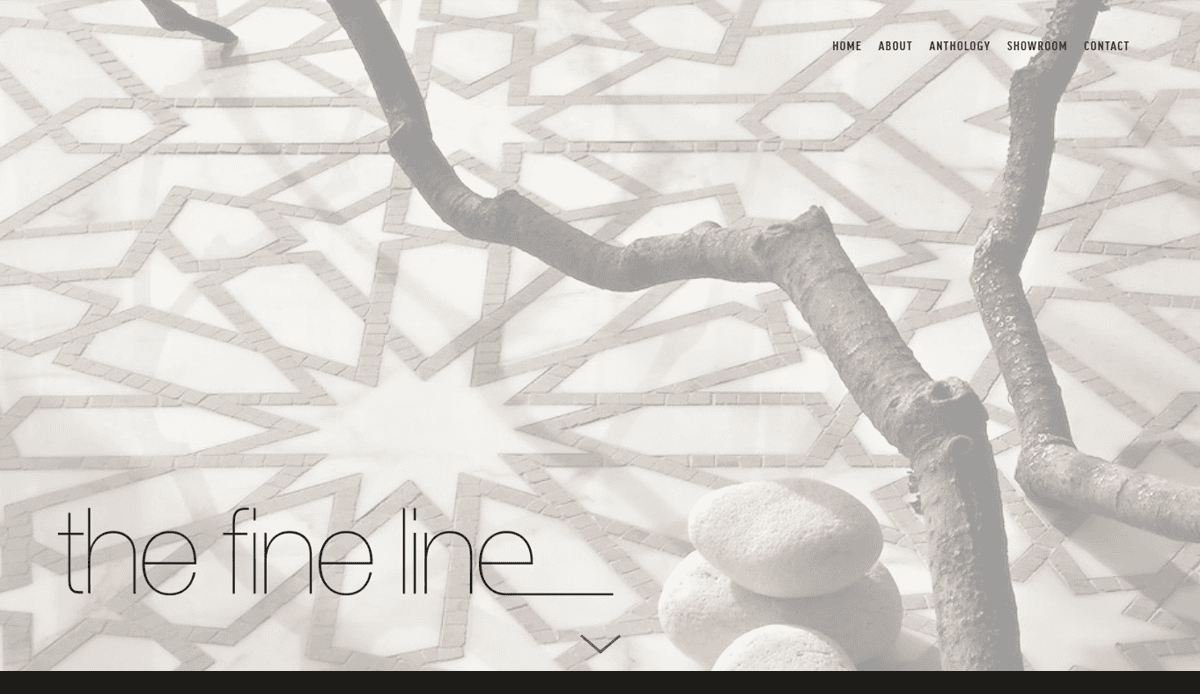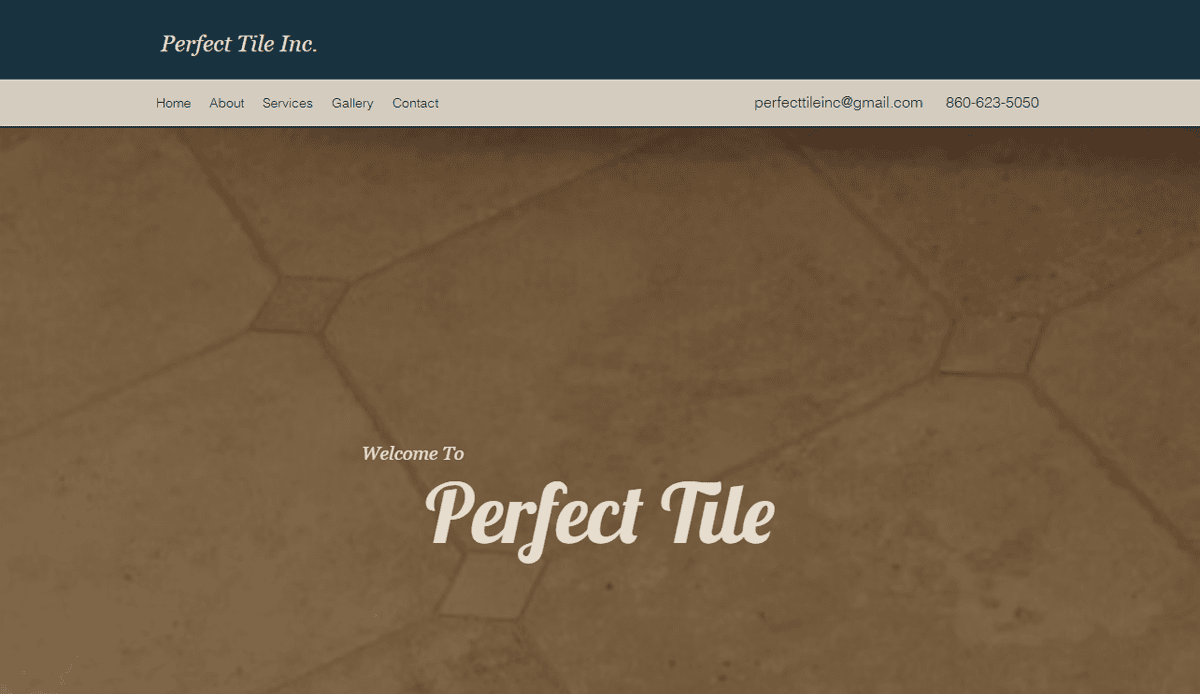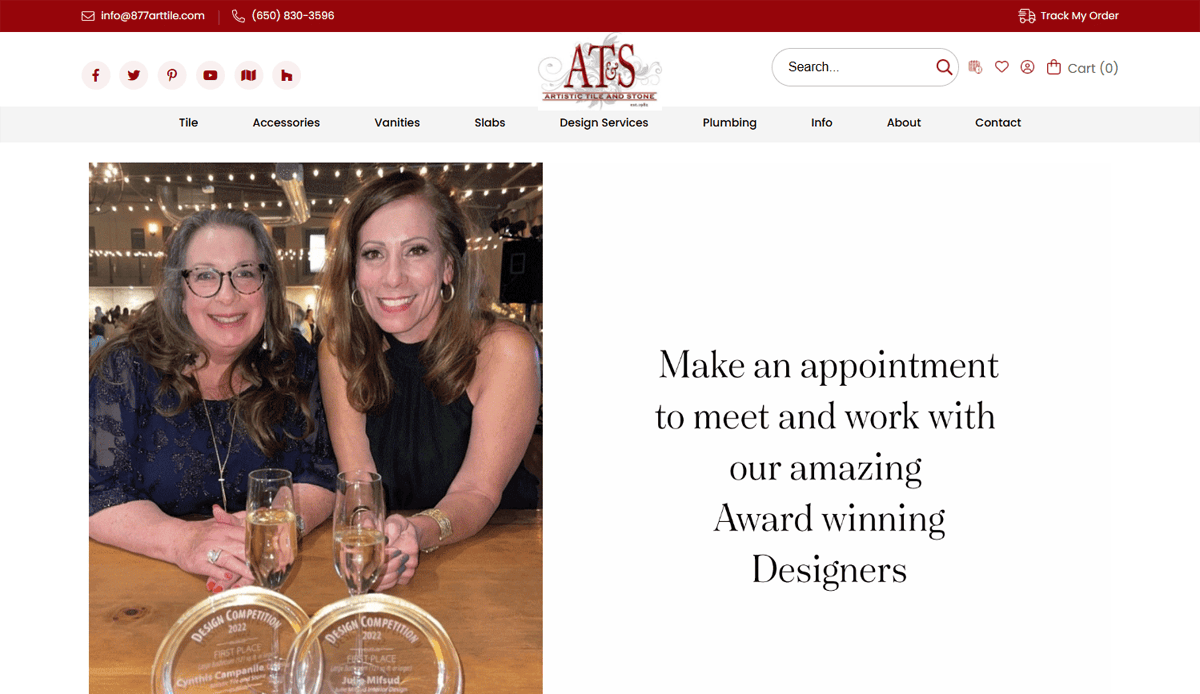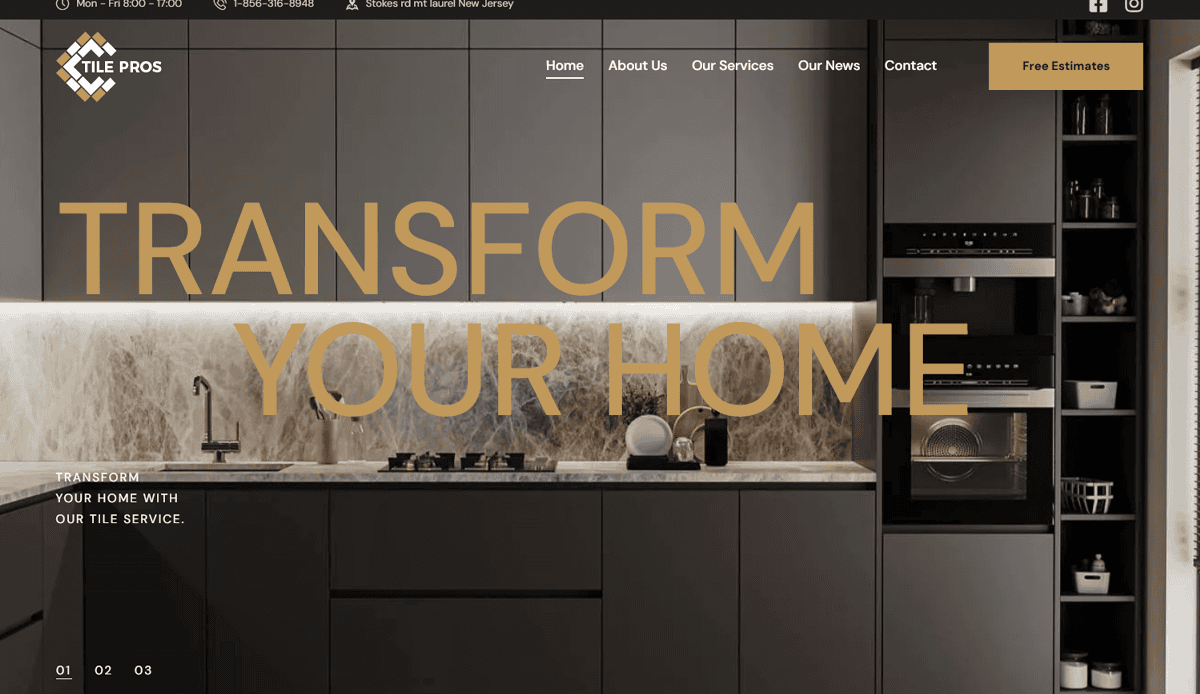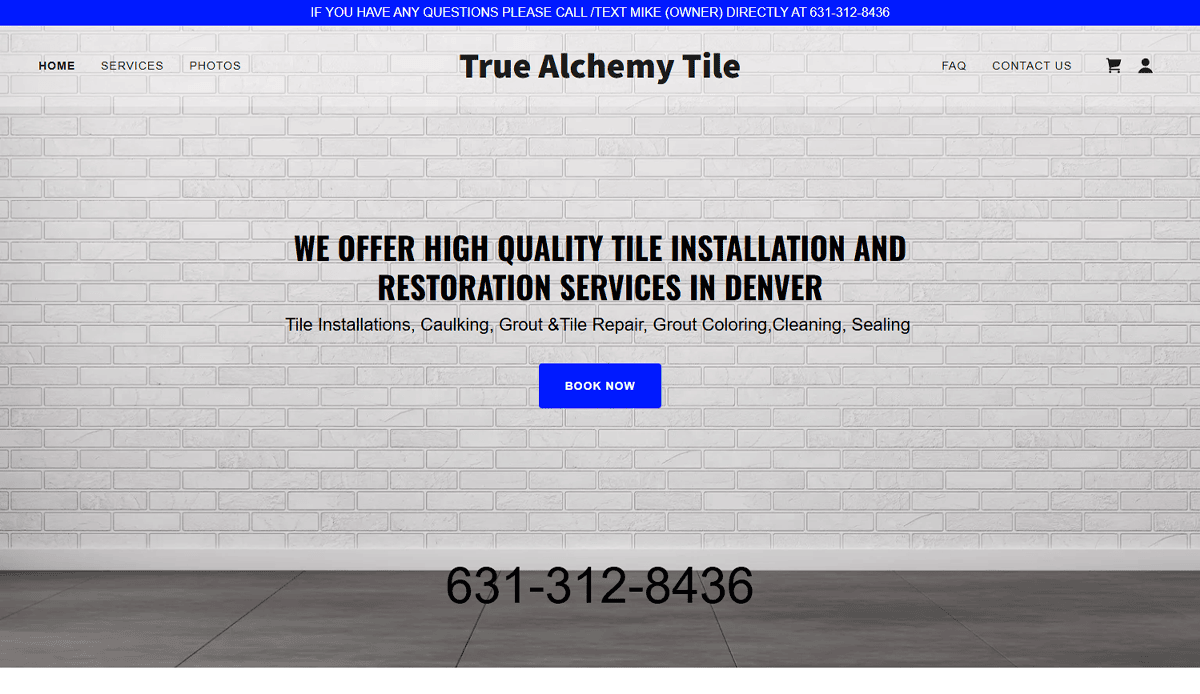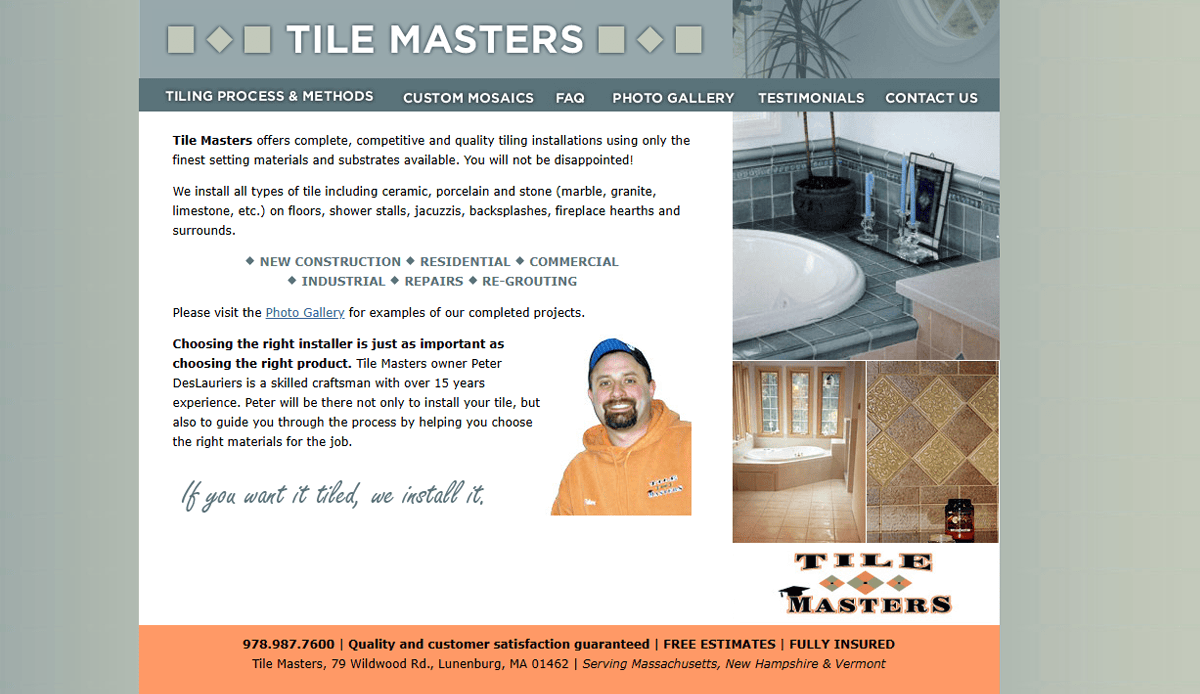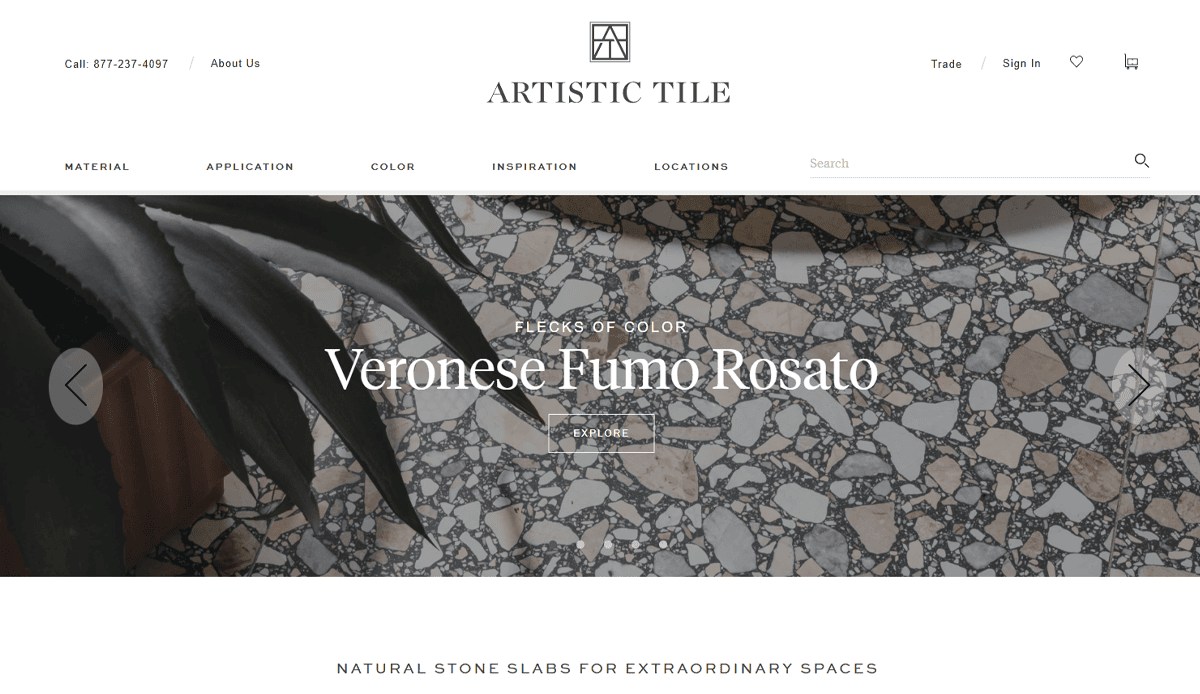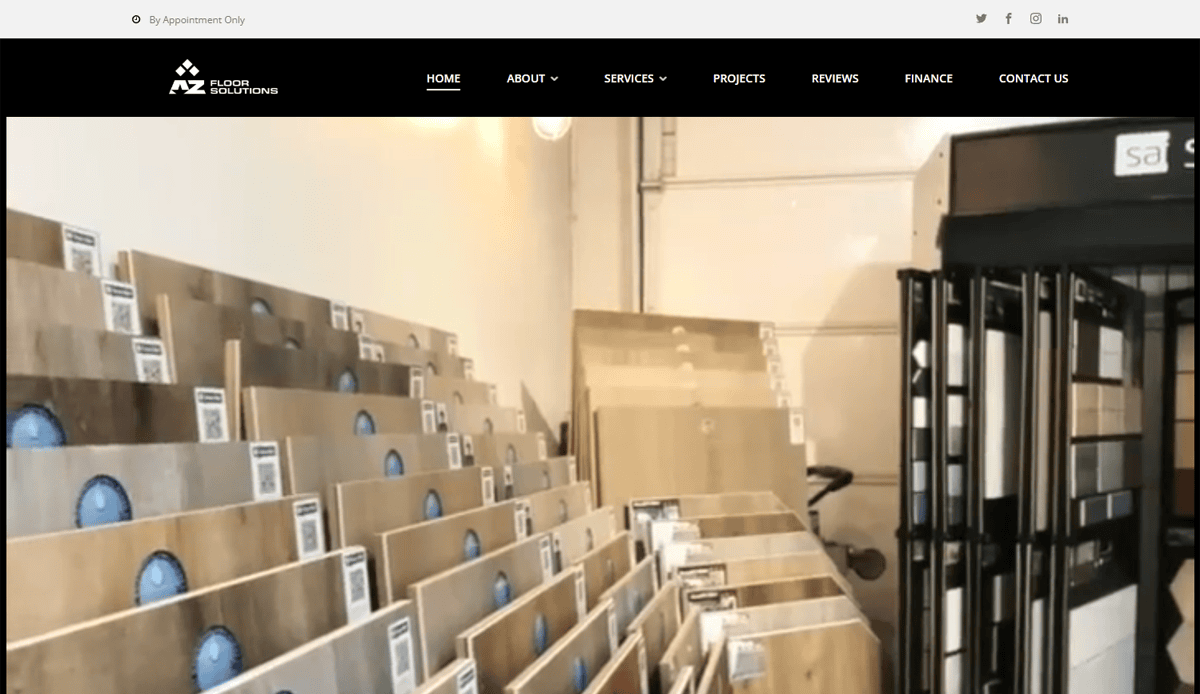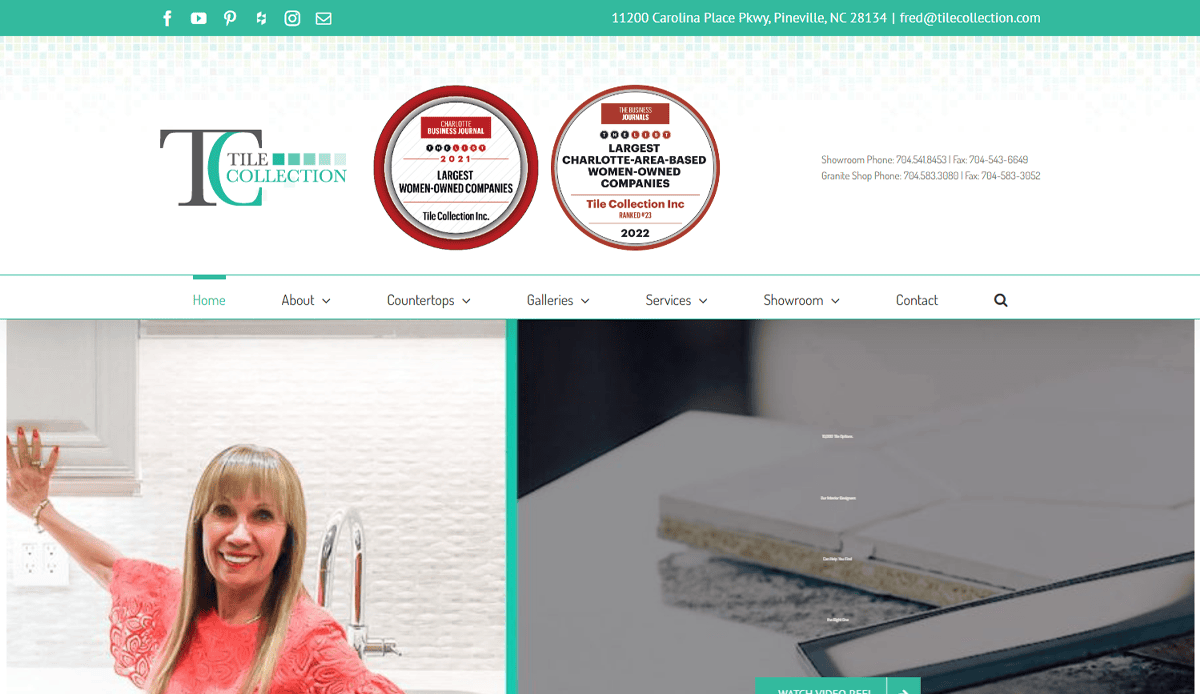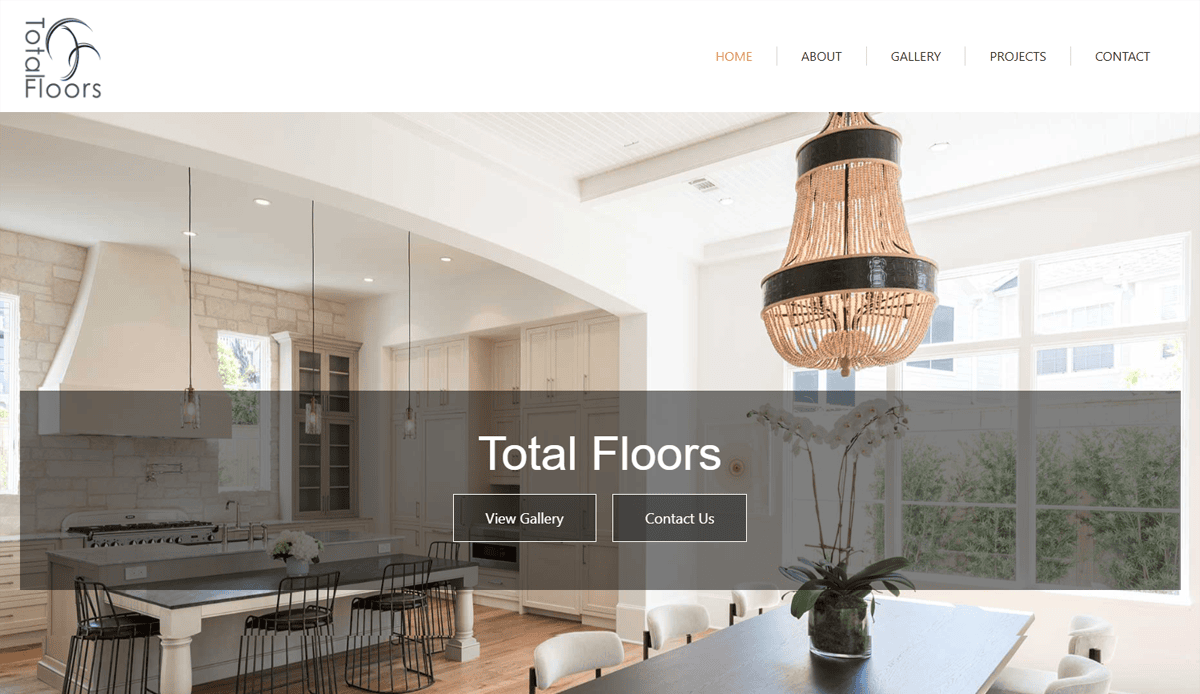Just looking for our Best Tile Contractor Website examples list?
Why Great Tile Contractor Website Design Matters for Your Business
Today, it’s a no-brainer that a great website is more than just an online presence—it’s a powerful marketing tool that can transform your business. For tile contractors, whether you’re focused on porcelain, ceramic, or tile installation, your website is often the first point of contact for potential customers. A poorly designed site can leave a bad impression and cost you valuable business, while a well-designed one can act as a lead magnet, converting visitors into new customers.
Your website’s layout, speed, and user-friendly design influence how quickly potential clients make decisions. From your homepage to your service pages, every element should reflect the quality of your services. A site that showcases your craftsmanship and provides easy navigation can make all the difference when remodeling a customer’s perception of your brand. But it doesn’t stop at aesthetics; your site needs to be functional, optimized for search engines, and responsive on all devices.
In this guide, we’ll show you how to build or revamp your tile contractor website to impress visitors, boost conversions, bring in more inquiries, and ultimately, more business. The right web design will highlight your expertise and will also make it easier for new customers to find you and trust your services. Let’s dive into why great design matters and how a high-performing site can directly impact your bottom line.
Website Planning & Purpose: Laying the Foundation for Success
The planning phase is one of the most critical steps in creating a website. This phase involves defining the website’s goals, identifying the target audience, and mapping out the essential features and pages that will best serve both your business and potential clients. Without careful planning, a website can quickly become cluttered, ineffective, and fail to achieve its intended purpose. A well-thought-out plan sets the stage for a user-friendly site that attracts new customers and drives conversions.
The first step in the planning phase is to establish a clear purpose for the website. Are you aiming to generate leads for tile installation services, showcase your portfolio, or provide information about your services? Understanding your primary goals will help guide the structure and content of your site. For instance, if your main goal is lead generation, your website should feature clear calls-to-action (CTAs), easy-to-fill contact forms, and testimonials to build trust with potential customers. On the other hand, if you’re looking to highlight past work, a visually appealing portfolio page featuring top-quality images of completed projects should be a priority.
The next step is identifying your target audience. In this industry, your customers might include homeowners looking to remodel, businesses requiring commercial installations, or property managers in need of flooring services. By understanding who you’re targeting, you can tailor the design and messaging to meet their specific needs. Your website should speak directly to these potential clients, offering solutions to their pain points, whether it’s helping them find the best tile materials for their remodel or showcasing your expertise in porcelain tile installation.
As part of this process, it’s also important to consider the functionality of the website. A company site should be easy to navigate, visually appealing, and mobile-friendly. Most people will access your site from their smartphones, so ensuring that your site is responsive is essential. Moreover, ensuring that your content is optimized for search engines (SEO) will help improve your website’s visibility and attract organic traffic.
At this stage, you should also think about content. Decide on the key pages your site will include, such as the home page, about page, services page, portfolio, and contact page. Each of these pages should be designed with your business goals in mind. For example, the services page should clearly outline the offering, while your portfolio should feature impactful images of your best work. Don’t forget about the importance of a blog or resources section, where you can share tips, trends, and tile-related news that further engages your audience and positions you as an expert in the field.
To guide your planning process and ensure your website is built to meet your business goals, consider working with experts like us, who specialize in creating contractor websites tailored to your needs. Visit our agency’s Website Design Services for Contractors to explore how professional web design can enhance your tile business. By taking the time to plan properly, you can create a website that looks great and drives business growth.
Design Principles for an Effective Website
Designing an effective website is about more than just aesthetics—it’s about creating an online experience that is intuitive, visually appealing, and functional. Key design principles guide this process, ensuring your website serves both your business and your clients effectively. In this section, we’ll discuss the foundational principles of site design that will help you create a professional, engaging, and high-converting site.
First and foremost, simplicity should be at the heart of it. A clean, minimalist design makes your site look modern and ensures that visitors can easily find the information they need without feeling overwhelmed. This means focusing on essential elements such as your services, portfolio, testimonials, and contact information, while avoiding unnecessary clutter. The goal is to keep the navigation straightforward, guiding users seamlessly through the site and toward key actions like requesting a quote or scheduling a consultation.
Another crucial design principle is visual hierarchy. Visual hierarchy involves arranging elements on your website in a way that naturally leads the visitor’s eye to the most important content first. This means making your services and call-to-action buttons prominent. Use headings, subheadings, and contrasting colors to highlight key sections, ensuring visitors understand what you offer and what action they should take next. Quality images of your projects should be prominently displayed, as they help demonstrate your skills and quality of work, encouraging potential clients to trust you with their projects.
Consistency is another principle that plays a critical role in web design. Consistent use of colors, fonts, and design elements strengthens your brand identity and improves UX. Using a consistent color palette that reflects the aesthetics of the materials you work with—such as neutral tones or earth colors—can evoke the right mood for your audience. It’s essential to ensure that fonts are legible, with clear distinctions between headings and body text, creating a structured flow for the content.
Responsiveness is non-negotiable. With the majority of users accessing websites through mobile devices, a responsive design is essential. This means your website should adjust seamlessly to different screen sizes, whether the user is on a phone, tablet, or desktop. The formatting, images, and text should scale appropriately, providing a user-friendly experience regardless of the device being used. A mobile-optimized website improves usability, reduces bounce rates, and increases the likelihood of converting visitors into clients.
Equally important is user experience (UX) design. A website that is easy to navigate and pleasant to use increases the chances of visitors staying longer and interacting with your content. This means structuring the site with clear menus, simple navigation, and fast loading speeds. Include a search feature to allow users to quickly find specific services or projects, and organize your portfolio by categories (e.g., bathroom tile, kitchen tile, floor tile, etc.) to help visitors find the exact services they need. An intuitive UX design will make prospective customers more likely to return to your site and recommend it to others.
Finally, trustworthiness is a key element of your web design. People want to feel confident that they’re hiring a reputable tile contractor. Incorporating trust signals such as client testimonials, certifications, affiliations with professional organizations, and before-and-after images of completed projects helps build credibility. Additionally, make sure your contact information is easy to find, and consider including a physical address or office location to reassure visitors that you are a legitimate business.
By adhering to these design principles, your website will look professional and provide a smooth, enjoyable visitor experience that encourages visitors to convert into loyal customers.
Content & Navigation: Structuring for Clarity and User Engagement
The structure of content and navigation on your website plays a significant role in how users interact with your site. Well-organized content and intuitive navigation ensure that visitors can easily find the information they need, leading to a better experience for visitors and higher conversion rates. This means focusing on clarity, relevance, and ease of access while also highlighting key aspects of your business, such as your services, portfolio, and customer testimonials.
Start with a clear, concise homepage that quickly communicates who you are and what you do. Visitors should be able to understand your business at a glance, whether they are looking for installation services, remodeling, or custom porcelain work. Use short, impactful messaging along with impactful images to convey your expertise. Your homepage should serve as a roadmap to the rest of your site, with easy access to essential pages like your services, portfolio, and contact information.
For navigation, simplicity is key. A well-organized menu ensures that visitors don’t have to search for what they need. Keep your main navigation bar minimal, with clear labels such as “Home,” “Services,” “Portfolio,” “About Us,” and “Contact.” Submenus can be used for more specific offerings, like “Tile Installation,” “Bathroom Remodeling,” or “Floor Tile Services.” By organizing content into logical categories, visitors will be able to find information quickly and without confusion. Additionally, incorporating a sticky navigation bar that remains at the top of the page as users scroll through your site provides easy access to key sections, improving overall usability.
Content should be strategically placed to guide users through the journey you want them to take on your website. The Services Page is another critical area where you outline the specific services you offer. Each service should have its own dedicated section or page, with detailed descriptions of what is included, why it’s important, and how it benefits the customer. This allows visitors to quickly assess whether your services match their needs. For example, the “Tile Installation” section should explain the process, types of tiles you work with, and the benefits of professional installation.
Next, the Portfolio or Gallery section should highlight your past projects through quality images and brief descriptions. This is your opportunity to show visitors the caliber of your work. Make sure the images are categorized by service type to help users quickly find relevant examples of your expertise. The portfolio should also include any before-and-after photos, as they can help demonstrate the transformative power of your services.
Calls-to-action (CTAs) should be placed strategically throughout the content. Whether on the homepage, service pages, or portfolio, each page should encourage visitors to take the next step, whether it’s contacting you for a quote, scheduling an appointment, or learning more about a specific service. Ensure that your CTAs are clearly visible, with action-oriented text such as “Get a Free Quote” or “Request Your Tile Installation Today.”
The About Us page offers an opportunity to build trust and connect with potential clients on a more personal level. It’s important to include information about your experience, values, and the quality of the materials you use, such as the top-quality porcelain tiles you specialize in. Potential clients want to know they are working with a reputable contractor who understands the nuances of their project.
Finally, Contact information should be easy to find, ideally in the navigation bar and at the footer of every page. This makes it simple for visitors to reach out to you without having to hunt for your phone number or email address. Include a contact form that asks for basic information, like name, phone number, and a brief description of the project. Additionally, offering multiple contact methods—phone, email, and even an online chat option—can accommodate different preferences and increase the chances of conversion.
To learn more about structuring your content and navigation for maximum impact, visit our Blog on Contractor Website Design. With a thoughtfully designed site, professionals like you can ensure that their potential customers can easily navigate and find exactly what they are looking for, making it more likely they will convert into long-term clients.
Visual Elements: Enhancing User Experience and Strengthening Your Brand
Visual elements play a crucial role in creating an engaging and effective website. The right combination of imagery, colors, typography, and layout improves the aesthetic appeal of your site, enhances the UX, and strengthens your brand identity. The visual elements on your website are an opportunity to showcase your craftsmanship, convey professionalism, and build trust with potential clients.
High-quality imagery is perhaps the most important visual element for a professional website. Since tile installation and remodeling are highly visual services, people expect to see examples of your work. Use high-resolution images that highlight the details and quality of the tile work you’ve completed. Showcase a range of projects, from kitchen and bathroom remodels to large commercial installations, allowing visitors to visualize how your services can transform their spaces. It’s also essential to use “before and after” photos to demonstrate the impact of your work, as these visuals can be persuasive in convincing clients of your expertise. Make sure the images are well-lit and professionally shot to capture the true beauty of your work.
Color choices on your website should reflect your brand’s identity while also enhancing the UX. Natural and neutral tones like whites, grays, and beiges work well, as they align with the colors of common tile materials such as porcelain and ceramic. These colors evoke a sense of cleanliness, simplicity, and professionalism, which are crucial for establishing credibility. However, don’t shy away from incorporating accent colors that complement your brand and draw attention to important sections like calls-to-action (CTAs), headers, and service highlights. The goal is to create a visually balanced design that is aesthetically pleasing while also guiding visitors toward key actions.
Typography is another critical visual element that can significantly impact the visitor’s experience. Your website’s fonts should be easy to read and accessible across all devices. Avoid using overly decorative fonts that may detract from the content. Instead, choose fonts that are clear and professional. Fonts that evoke a sense of trust and stability, such as sans-serif or serif fonts, can help communicate the reliability and expertise of your business. Ensure that the font sizes are well-balanced, with headings standing out for easy navigation and smaller text used for descriptions or details.
White space, or negative space, is a design element that is often overlooked but is extremely important for creating a clean, uncluttered look. It allows your content to breathe and makes it easier for users to focus on the key areas of your website. In an industry where showcasing images of intricate tile designs is essential, white space ensures that your visuals are not overshadowed by excessive text or crowded sections. A spacious design helps visitors absorb information without feeling overwhelmed and ensures a smooth browsing experience.
Consistency in visual elements across your site reinforces your brand identity. Use a consistent color palette, typography, and layout throughout the site to create a cohesive look that feels professional and organized. When visitors see a consistent design, it builds trust and makes the site easier to navigate. For example, if your logo uses specific colors, make sure these are incorporated into your buttons, links, and other visual elements to create a uniform appearance.
Icons and buttons are also vital for guiding users through your site. Use visually intuitive icons for actions like contacting you, viewing your portfolio, or requesting a quote. These help users easily understand what they can do next and create a more seamless experience. The design of your buttons should stand out without being overpowering, using contrasting colors to draw attention to key actions such as “Get a Free Quote” or “Request More Information.” When buttons are easily recognizable and placed strategically, they encourage users to take action, which is crucial for lead generation.
For more on how visual elements can enhance your website’s lead generation potential, check out our Blog on Contractor Marketing Website Lead Generation. By thoughtfully incorporating these visual design principles, designers can create a website that attracts visitors and provides an exceptional overall experience that converts them into loyal customers.
Ongoing WordPress Maintenance: Ensuring Your Site Stays Efficient and Secure
Ongoing maintenance is a vital aspect of managing a WordPress website, especially for those who rely on their online presence to generate leads and showcase their services. A website that is not regularly updated or maintained can become slow, insecure, and prone to errors, which can negatively impact UX and, ultimately, business performance. By investing in ongoing WordPress maintenance, you ensure that your website remains functional, secure, and optimized to perform at its best.
One of the most important aspects of ongoing maintenance is keeping WordPress, themes, and plugins up to date. WordPress regularly releases updates to improve the platform’s security, functionality, and performance. Similarly, theme and plugin developers release updates to add new features, fix bugs, and address security vulnerabilities. Without these updates, your website may become vulnerable to security breaches, which can compromise sensitive information and damage your business’s reputation. Ensuring that your website is running the latest versions of WordPress, themes, and plugins minimizes risks and keeps your site running smoothly.
Security is another critical element of ongoing maintenance. As a business owner, you want to ensure that your website is secure from hackers and malicious attacks. Regularly monitoring your website for signs of security issues, such as malware or unauthorized access, helps prevent these threats from affecting your site. Using security plugins, setting up firewalls, and ensuring your website is running on HTTPS are essential steps in maintaining a secure WordPress website. It is also advisable to create regular backups of your website, so in the event of a security breach or technical issue, you can restore your site quickly without losing valuable data.
Site speed optimization is crucial for both UX and search engine ranking. Websites that load slowly can frustrate visitors, causing them to leave your site before they even get a chance to explore your services. Slow load times can also harm your search engine rankings, as search engines prioritize fast-loading websites. Ongoing maintenance should include regularly checking and optimizing the website’s speed by reducing image sizes, caching static content, and eliminating unnecessary scripts that could slow down the page load time. This ensures that potential clients can quickly browse your portfolio, request a quote, or contact you without delay.
Another important area of ongoing maintenance is content management. You may need to update your website with new projects, services, or blog content regularly. This keeps your website fresh, informative, and relevant to both your clients and search engines. Additionally, regularly updating your content helps with optimization, as search engines favor websites that provide fresh, quality content. Whether it’s adding new project galleries, updating your services page, or writing blog posts about the latest tile trends, consistent content management is essential for engaging visitors and attracting new clients.
Database optimization is also a crucial part of WordPress maintenance. Over time, WordPress databases can become cluttered with outdated data, such as post revisions, spam comments, and other unnecessary information. Regularly cleaning up and optimizing the database improves the overall performance of the website, ensuring faster load times and better resource management. This is especially important for those who may have extensive portfolios and large numbers of pages that need to be accessed quickly by potential customers.
Lastly, testing and troubleshooting are key components of ongoing website maintenance. Regularly testing your website’s functionality ensures that all links, forms, and interactive elements are working correctly. This includes ensuring that contact forms, quote request forms, and other client interaction points function smoothly. If issues arise, troubleshooting helps identify and resolve problems before they affect the user or result in missed business opportunities.
By committing to ongoing WordPress maintenance, professionals can keep their websites running efficiently, securely, and at peak performance. Regular updates, security checks, speed optimization, content management, and database optimization ensure that your website continues to generate leads and represent your business professionally. Without consistent maintenance, a website can quickly become outdated, slow, and prone to security vulnerabilities, ultimately harming your business’s credibility and growth.
Best Tile Company Website Design Examples
1. The Fine Line Tile
Location: Chicago, IL
Key Takeaways:
- Clean, modern layout that highlights design styles and services.
- Interactive gallery with high-resolution photos of custom tile projects.
- Well-organized pricing section to help customers quickly assess costs.
2. Tile & Stone Consultants
Location: New York, NY
Key Takeaways:
- Large portfolio section featuring detailed before-and-after images of tile installations.
- Clear service areas are listed with an easy-to-access contact form.
- Integrated customer reviews and testimonials that build trust.
3. Perfect Tile Installers
Location: Connecticut
Key Takeaways:
- Smooth navigation that includes both service descriptions and project galleries.
- Simple and effective CTA buttons that guide visitors to request a quote.
- An optimized blog that shares tile trends, tips, and FAQs.
4. Heritage Hardwood & Tile
Location: St. Petersburg, FL
Key Takeaways:
- User-friendly navigation highlighting a wide variety of tile products and flooring options.
- A responsive design optimized for both desktop and mobile devices to reach all potential clients.
- A detailed portfolio showcasing successful projects that build credibility and trust.
5. Cancos Tile & Stone
Location: New York
Key Takeaways:
- Clean layout with a strong focus on customer satisfaction and showcasing testimonials.
- Effective use of quality images of ceramic and porcelain tiles in different design styles.
- Comprehensive service descriptions, including both residential and commercial projects.
6. Tile & Stone Gallery
Location: Oak Brook, IL
Key Takeaways:
- Engaging homepage with a prominent call-to-action that encourages users to schedule consultations.
- Optimized for search engine optimization (SEO) to rank for local searches.
- Detailed service pages that highlight the unique features of tile products and the installation process.
7. Elite Tile Installers
Location: Oakpark, IL
Key Takeaways:
- Great images and a bold design highlight tile installation projects.
- Streamlined navigation with easy access to various services, fostering a smooth user journey.
- A strong focus on promoting online reviews and client testimonials for trust-building.
8. Artistic Tile & Stone
Location: Austin, TX
Key Takeaways:
- Interactive product display for customers to explore various textures and styles.
- Excellent use of project case studies, providing detailed examples of successful installations.
- Streamlined navigation with easy access to pricing and service options.
9. Tile Contractor Services
Location: Seattle, WA
Key Takeaways:
- Seamless layout that balances information and visuals to create an engaging user experience.
- Dedicated blog providing tips and insights for customers considering tile installation.
- Easy-to-navigate, with intuitive design tools for customizing tile selections.
10. True Alchemy Tile
Location: Denver, CO
Key Takeaways:
- Simple, clean design that clearly communicates services, benefits, and contact options.
- Focus on local SEO to help customers in Denver and the surrounding areas find the site easily.
- Easy-to-understand service breakdowns with pricing and expectations outlined upfront.
11. Tile Master Contractors
Location: Boston, MA
Key Takeaways:
- High-resolution images and client testimonials add credibility and trustworthiness.
- Service areas are well-highlighted, and a user-friendly search function helps potential clients.
- Prominent “Get a Free Quote” button that guides visitors through the consultation process.
12. Artistic Flooring and Tile
Location: Multiple Locations in the USA
Key Takeaways:
- Easy-to-browse gallery showing completed installations with clear categorization.
- Well-written content highlighting various types of flooring and tile, including ceramic and porcelain.
- Mobile-optimized design ensures a smooth browsing experience across all devices.
13. AZ Floor Solutions
Location: Phoenix, AZ
Key Takeaways:
- Full-service website with clear calls to action and user-friendly navigation.
- Engaging service pages detailing everything from tile types to installation processes.
- Client-focused, offering valuable content and FAQ sections about tile products and installation.
14. The Tile District
Location: Los Angeles, CA
Key Takeaways:
- Stylish, visually appealing homepage with interactive tiles and videos of installation projects.
- Seamless integration of an online store for tile products and materials.
- Focused on customer education with a dedicated section for tile education and installation tips.
15. Tile Collection
Location: Charlotte, NC
Key Takeaways:
- Well-organized service offerings with a section dedicated to project types, including bathroom and kitchen tiles.
- Easy navigation with direct links to special offers and promotions.
- Use of customer success stories and before-and-after images to inspire potential clients.
16. Pratt + Larson
Location: Portland, OR
Key Takeaways:
- Focus on industry standards and customer satisfaction, with detailed service pages.
- Interactive elements allow customers to explore different tile sizes and designs.
- Strong emphasis on online reviews and client testimonials to build credibility.
17. Total Floors
Location: Houston, TX
Key Takeaways:
- Simple yet effective design that emphasizes fast navigation to key service areas.
- Excellent project portfolio showcasing a variety of tile products and installations.
- Clear calls-to-action inviting customers to request a free estimate or consultation.
Take Action: Elevate Your Tile Contractor Website
Now that you’ve learned the essential principles of tile contractor website design, it’s time to take action. A modern website can be a powerful tool in helping you attract more customers, showcase your tile projects, and establish your presence in the competitive tile industry. Whether you’re a seasoned tile installer or new to the business, investing in a professional website that reflects your unique design style and commitment to customer satisfaction is crucial for success.
Incorporating key features like HD images and videos of your ceramic tile and porcelain installations, offering an engaging experience, and optimizing for search engine rankings will allow you to stand out from the competition. If you’re ready to transform your online presence and grow your business, reach out today to learn more about how our full-service digital marketing agency can help you create a new website that meets your business needs and helps you improve your search engine rankings. Whether you’re looking to optimize your social media profiles or need helpful tips on selecting a tile or improving your installation process, we’re here to guide you every step of the way.
Take the next step toward a more successful online presence. Contact us today to schedule your free consultation and start building your modern website.
Common Questions About Tile Contractor Web Design, Answered
How can I differentiate myself from competitors in the tile industry?
To differentiate yourself from competitors in the tile industry, focus on showcasing the unique design elements of your tile projects and your commitment to quality standards. Highlight the variety of textures you offer, including options like ceramic and porcelain tiles, which are highly sought after by interior designers. Additionally, consider creating a focal point in your online portfolio that emphasizes your expertise in both home improvement and tile products. Digital marketing efforts, such as optimizing your website with effective search engine optimization strategies, can also help your business stand out online. Learn more about how digital marketing can help your business grow by checking out our guide on Contractor Website Design and Lead Generation.
What are the best marketing channels for promoting my tile contractor business?
The best marketing channels for promoting your business include both online reviews and social media platforms like Instagram. Encouraging satisfied customers to leave reviews can improve your credibility and attract new clients. Sharing photos and videos of your completed tile projects on platforms like Instagram helps you engage with potential clients and showcase your skills visually. Pair this with a business-focused website that features search engine optimization to increase your visibility on search engines. Integrating these marketing and advertising strategies will allow you to effectively reach your target audience and increase business leads.
How does search engine optimization (SEO) impact my website?
Search engine optimization (SEO) is critical for your website because it helps improve your visibility on search engines, making it easier for prospective customers to find your services. By optimizing your site for relevant keywords, such as tile products, ceramic and porcelain tiles, and home improvement, you increase the likelihood of appearing in search results when customers are looking for tile installers. Good SEO also enhances your UX by making the site easier to navigate and ensuring that it loads quickly. For more tips on how SEO can help, visit our Contractor Marketing and Website Lead Generation page.
How do online reviews affect my business?
Online reviews are a powerful marketing tool that can significantly impact your business. Positive reviews build trust with potential clients and can influence their decision to hire you. Encourage clients to leave feedback about the services you provide, and feature these testimonials prominently on your website. Regularly monitoring and responding to reviews can also help improve your business focused reputation and show that you value customer feedback. Additionally, reviews can contribute to better SEO rankings, helping you attract more local clients. Learn more about managing online reviews and leveraging them for growth in our guide on Marketing Channels for Contractors.
What should be included in my website to attract more clients?
To attract more clients, your website should include impactful images and detailed descriptions of the tile products and services you offer. Showcasing a variety of textures, including ceramic and porcelain, and detailing the installation process will help visitors understand what you offer and the quality of your work. Make sure your website is mobile-friendly and optimized for search engine optimization (SEO) to improve its visibility. Additionally, include clear ways to contact you, such as a contact form, phone number, and email address, and encourage visitors to request a quote or schedule an appointment. For more detailed advice on website design, check out our Contractor Website Design and Lead Generation page.
How can I leverage social media to promote my business?
Social media platforms like Instagram are great for showcasing your work and engaging with new customers. Post strong images and videos of your tile projects to highlight the tile products you specialize in, such as ceramic and porcelain tiles. Use these platforms to create a focal point for your business by sharing behind-the-scenes content, customer testimonials, and frequently asked questions (FAQs) about your services. Social media is also an excellent tool for connecting with interior designers and home improvement enthusiasts who might be interested in your services. Regularly updating your social media profiles will help attract more attention and improve your online presence.
How do I ensure my services meet quality standards?
Ensuring your services meet quality standards is essential for maintaining customer satisfaction and growing your business. You should regularly train your team on the latest techniques and trends in the tile industry, such as proper grout installation and tile size considerations. Additionally, following the best practices outlined by industry leaders like the Tile Council of North America ensures that your services align with the highest professional standards. Displaying certifications and showcasing your work on your website and through marketing and advertising materials can also reinforce your commitment to providing high-quality services.
What are some helpful tips for selecting the right tile for a project?
When selecting the right tile for a project, it’s important to consider factors such as tile size, the area’s function (e.g., bathroom, kitchen, or floor), and the design style you want to achieve. Offer clients a variety of options, including ceramic and porcelain tiles, and explain the benefits of each based on durability, aesthetics, and cost. Be sure to discuss how different tile textures can create a focal point or complement a particular interior design. Additionally, stay updated on the latest trends in the tile industry to offer clients modern and stylish options. For more advice on tile selection and installation, visit our Marketing Channels for Contractors page.

